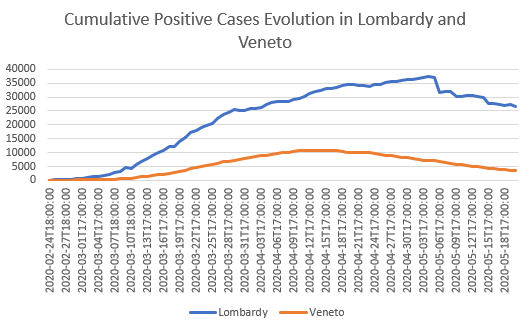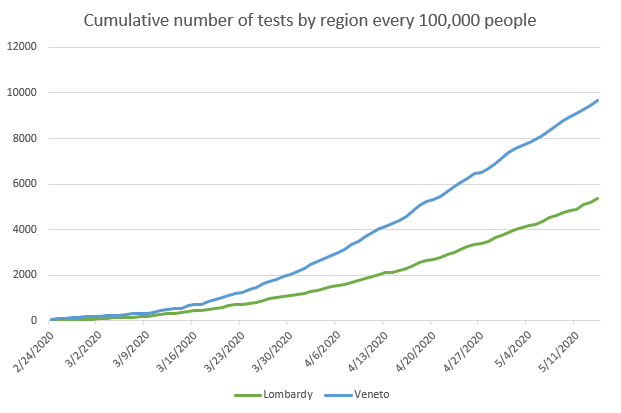Two COVID-19 testing strategies for two Italian Regions: A history of success and failure
From being the first two Italian regions with COVID-19 cases, Lombardy and Veneto followed two very different trajectories in the coming months of the pandemic. Lombardy became unfortunately famous for being the most-hit region in Italy, by both numbers of infections and deaths. Veneto instead, managed to contain the infection, and has now very low numbers compared to Lombardy. Both regions have allegedly good regional healthcare systems (better functioning than many other Italian regions and other European countries), so what did Veneto do that Lombardy did not?

The Beginning
COVID-19 cases in Italy started rising towards the end of February 2020. There were two initial epicenters of the outbreak, one in Codogno, in the province of Lodi in Lombardy, and one in Vo’, in the province of Padua in Veneto. The two towns were put into lockdown in order to contain the virus, but this did not prevent it to expand to other provinces and regions. In the last week of February cases were confirmed in neighboring regions such as Piedmont, Emilia-Romagna and soon the virus reached almost all regions in Italy from north to south.
In the coming weeks, Lombardy’s cases started to soar, together with the number of people hospitalized in intensive care and the number of deaths. Ever since, up until today, Lombardy is the most hit region, by the number of infections, intensive care hospitalizations, and casualties. Veneto instead, from being one of the first two epicenters of the virus in Italy, with tens of people being infected in the first days of the epidemic, followed a very different evolution.
The numbers today
As of May 21, 2020, according to official government data, Lombardy has 85,775 total cumulative cases, with more than 15,600 casualties whereas Veneto has so far 19,030 total cumulative cases and about 1,800 casualties. It is clear that the two regions have very different numbers. There is however a figure for which Lombardy and Veneto have a much similar value: the number of tests carried out. As of today, Lombardy performed a total cumulative of 607.863 tests, whereas Veneto carried out 536.798.
Considering that the population of Lombardy is two times that of Veneto, this means that overall, Veneto implemented a test-intensive strategy, while Lombardy did not.

Testing Strategies
Lombardy
As the number of cases began to soar and hospitals’ ICU beds started reaching capacity, the president of the Region, Attilio Fontana, decided to test only people with serious symptoms due to the limited diagnostic capacity of the region. This was backed by the recommendations published by the Ministry of Health on March 9, which read “people with symptoms should be tested”.
Up until late April, Lombardy denied testing to people who requested it, unless they had significant symptoms. GP were instructed to do a triage over the phone and if the patient did not have a respiratory crisis or symptoms that would require hospitalization, the doctor would just suggest they’d keep them informed on the evolution of the symptoms. In addition to this, articles from trustworthy newspapers, have recently stated that Lombardy did not test people with symptoms (even serious ones), thus implying that Lombardy’s authorities have been concealing the truth and that they have not actually followed the Ministry of Health guidelines.
Veneto
When the first patient affected by Covid-19 was identified in Vo’ on February 23, the region supported the proposal of a group of professors and researchers from the University of Padua, to carry out an epidemiological study on the entire population of Vo’, testing everyone in the town.
The results obtained provided a fundamental input in the medical research on the nature and ways of spreading of the virus, since the study was carried out on a population with statistically significant size. But most importantly, this study produced some crucial information to design a containment strategy more suited to the nature of this new virus. Among the results obtained, the study showed a very high share (45-50 percent) of asymptomatic infected people able to transmit the virus.
With this result in mind, Veneto developed the so-called “active surveillance” strategy. The important aspect of this strategy is the planning of the tests: at the first appearance of symptoms (even mild) the patient is tested (together with the people living with her/him). Then a reconstruction of all the people that the patient came in contact with during the previous days is put together, and once these people are identified, they are also tested. Each time a new positive case is found, the procedure is repeated.
In this way Veneto proceeds by concentric circles to identify the potential carriers of the virus- even if asymptomatic- with a higher probability.

Conclusions
Veneto: A winning Strategy: The two regions opted for two opposite testing strategy: Lombardy tested only the symptomatic patients (with already advanced symptoms), while Veneto proceeded to test symptomatic AND asymptomatic people, by mapping the contacts of the infected individuals. Veneto seems to have followed an approach more similar to Germany and South Korea. These are two countries that have managed to limit both the number of new cases and deaths, by recognizing the importance of testing asymptomatic patients.
Scientific opinion leveraged: While Lombardy (allegedly) followed the guidelines of the Ministry of Health, based on the WHO recommendations, the region of Veneto, from the very beginning of the crisis, resorted to a team of scientists and epidemiologists to build a strategy that would best suit the situation. Does this mean that the MoH recommendations are flawed? Or being recommendations, they should be contextualized and tweaked based on the specific needs and capabilities of each region?
Public debate and Lombardy’s defense: In the last few weeks a public debate started in Italy on whether Lombardy should be held accountable for the mismanaging of the crisis. The region’s authorities argued that the lack of testing resources and of laboratories forced them to reduce the number of tests and limit them to urgent cases only. They also point at the latest Ministry of Health recommendations from April 4, in which there is a list of people that should be tested in order of priority (in case there is a limited capacity of tests and a state of necessity), in this list, asymptomatic people figure only if they are healthcare staff.
However, the same document states also that “if the diagnostic capacities are not sufficient, it is allowed to further expand the number of additional laboratories identified by the Regions and coordinated by the regional reference laboratories, considering the possibility of using mobile labs or drive-in clinics”. Has Lombardy taken advantage of this last point?
Lombardy’s mismanagement, are there causes rooted in the regional healthcare policy? It is still early and rather difficult to assess to what extent Lombardy’s failure was inevitable or if it was the result of flawed and possibly completely wrong decisions of its authorities.
However, as a recent review of an Italian newspaper suggests, Lombardy’s healthcare system malfunctioning could be attributed to Lombardy’s healthcare policies over the last decades, which highly incentivized the private sector. Nowadays about half of the region’s HC structures are private. Private structures in Lombardy over the years have specialized in profitable services, such as surgical operations and specialists’ visits, while emergency services- being less profitable- were not developed and left to public structures. As a result of this, even though private health care weighs about half of the entire Lombard healthcare system, it has just over a quarter of the intensive care unit beds in the region. Moving forward in the analysis, this aspect should be taken into consideration in order to understand what could have been done better, especially in the face of future emergency situations.
Is the testing strategy the ultimate culprit? It is still unclear the extent to which Lombardy’s testing strategy contributed to its high numbers of cases and deaths. This article aimed at comparing two regions that have many similarities, such as healthcare system advancement, favorable economic conditions, and developed technology. With this in mind, since the two regions’ approaches varied substantially in terms of testing strategy, it is fair to attribute some degree of importance to this, while the research continues to assess responsibilities in order to avoid further mistakes in the future.
Pietro Morabito – Senior Analyst
Sources
https://www.fnopi.it/wp-content/uploads/2020/03/Circolare_9_marzo_2020.pdf
https://www.ilpost.it/2020/05/04/pandemia-coronavirus-lombardia/
https://www.ilpost.it/2020/04/23/tamponi-andrea-crisanti/
https://www.startmag.it/mondo/covid-19-lombardia-veneto/
You may also like
Warning: Undefined variable $content in /var/www/sdomains/nexatestwp.com/infomineo.nexatestwp.com/public_html/wp-content/themes/infomineo/single.php on line 235
Warning: Undefined variable $content in /var/www/sdomains/nexatestwp.com/infomineo.nexatestwp.com/public_html/wp-content/themes/infomineo/single.php on line 235
Warning: Undefined variable $content in /var/www/sdomains/nexatestwp.com/infomineo.nexatestwp.com/public_html/wp-content/themes/infomineo/single.php on line 235
Warning: Undefined variable $content in /var/www/sdomains/nexatestwp.com/infomineo.nexatestwp.com/public_html/wp-content/themes/infomineo/single.php on line 235
Warning: Undefined variable $content in /var/www/sdomains/nexatestwp.com/infomineo.nexatestwp.com/public_html/wp-content/themes/infomineo/single.php on line 235
Warning: Undefined variable $content in /var/www/sdomains/nexatestwp.com/infomineo.nexatestwp.com/public_html/wp-content/themes/infomineo/single.php on line 235








